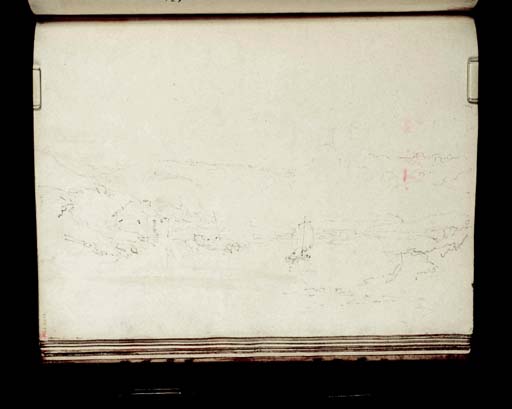Joseph Mallord William Turner Norham: The Castle from the West, with the River Tweed in the Foreground 1797
Image 1 of 2
Joseph Mallord William Turner,
Norham: The Castle from the West, with the River Tweed in the Foreground
1797
Joseph Mallord William Turner 1775–1851
Folio 61 Recto:
Norham: The Castle from the West, with the River Tweed in the Foreground 1797
D00966
Turner Bequest XXXIV 57
Turner Bequest XXXIV 57
Pencil on white wove paper, 210 x 270 mm
Blind-stamped with Turner Bequest monogram bottom centre
Stamped in black ‘XXXIV 57’ bottom left, descending vertically
Blind-stamped with Turner Bequest monogram bottom centre
Stamped in black ‘XXXIV 57’ bottom left, descending vertically
Accepted by the nation as part of the Turner Bequest 1856
References
1909
A.J. Finberg, A Complete Inventory of the Drawings of the Turner Bequest, London 1909, vol.I, p.72, XXXIV 57, as ‘Norham Castle’.
1974
Martin Butlin, Andrew Wilton and John Gage, Turner 1775–1851, exhibition catalogue, Royal Academy, London 1974, pp.39, 172.
1975
Luke Herrmann, Turner, Paintings, Watercolours, Prints & Drawings, London 1975, pl.184.
1993
Harry Madgwick, ‘Turner in Northumberland in 1797’, Turner Society News, no.63, March 1993, p.8.
1996
David Hill, Turner in the North: A Tour through Derbyshire, Yorkshire, Durham, Northumberland, the Scottish Borders, the Lake District, Lancashire and Lincolnshire in the Year 1797, New Haven and London 1996, pp.88, 191, pl.125.
1997
Charles Nugent and Melva Croal, Turner Watercolors from Manchester, exhibition catalogue, Memphis Brooks Museum of Art, Memphis 1997, p.44.
The subject is drawn with the page turned horizontally. Norham formed part of the County Palatine of Durham and it was Bishop Hugh de Puiset of Durham who built the keep of the castle in the later twelfth century, using as his architect Richard of Wolviston.1 David Hill suggests2 that the relative slightness of Turner’s drawing is a result of his having to make it soon after dawn, with the sun directly in his eyes. He made another pencil study of Norham, closer to the castle, on a separate sheet (Tate D00682; Turner Bequest XXVII U). The site was a potent inspiration for him both in the 1790s and later in his career. Two large finished watercolours based on this general view from upstream were created in the years immediately following the tour (private collection, and The Higgins Bedford);3 one of these was shown at the Royal Academy in 1798 (353) under the title Norham Castle on the Tweed, Summer’s morn. Colour studies related to these two works are Tate D02343 and D02344 (Turner Bequest L B, C).
Turner revisited the site in 1801 and made further sketches in his Helmsley sketchbook (Tate D02538– D02539; Turner Bequest LIII 44a–45). These seem to have been used for the sepia drawing of Norham for the Liber Studiorum published 1816 (see Tate D08158; Turner Bequest CXVIII D), and for the watercolour of Norham in the series of Rivers of England (Tate D18148; Turner Bequest CCVIII O).4 Another view occurs in an illustration to a line from Sir Walter Scott’s Marmion, ‘Day sat on Norham’s castled steep’, one of a group of watercolours made for Walter Fawkes in the early 1820s (private collection);5 and Norham Castle – Moonrise (private collection)6 figured among the illustrations to Scott’s Prose Works that Turner produced in the early 1830s (Tate impression: T04731). An ethereal retrospective meditation on the subject is the famous late oil painting Norham Castle, Sunrise (Tate N01981),7 which again takes this drawing as its starting-point, and makes dramatic use of the dazzling effect of the early sun. A small watercolour on card showing the castle at the end of the village street is Tate D36625 (Turner Bequest CCCLXXIX 1).
Verso:
Blank; stamped in brown ink with Turner Bequest monogram.
Andrew Wilton
January 2013
How to cite
Andrew Wilton, ‘Norham: The Castle from the West, with the River Tweed in the Foreground 1797 by Joseph Mallord William Turner’, catalogue entry, January 2013, in David Blayney Brown (ed.), J.M.W. Turner: Sketchbooks, Drawings and Watercolours, Tate Research Publication, November 2014, https://www


